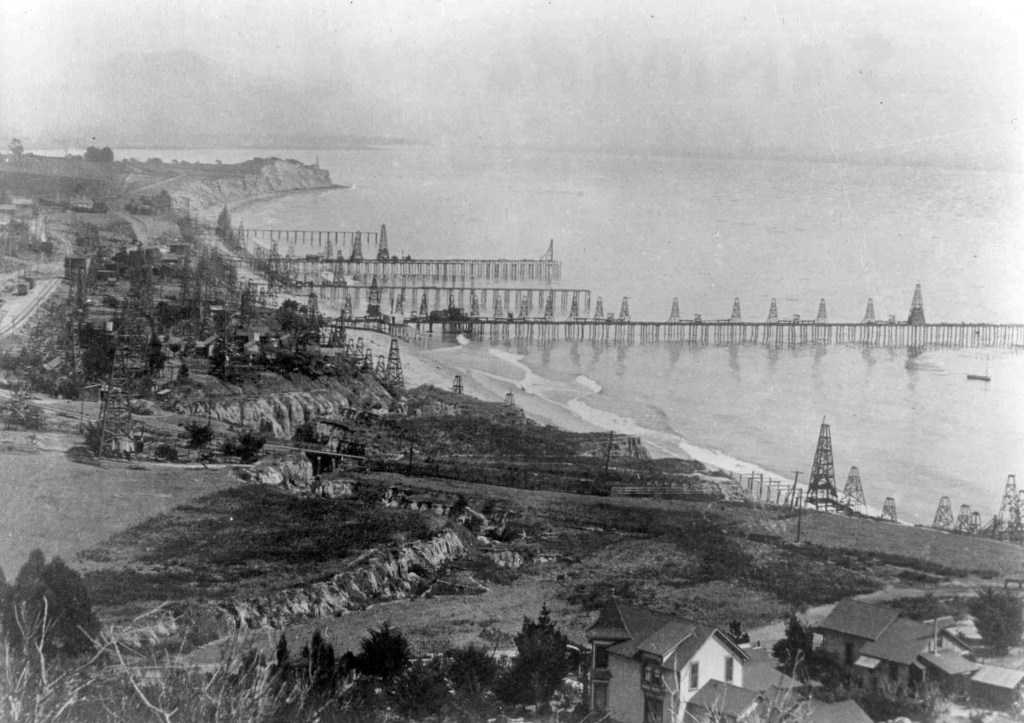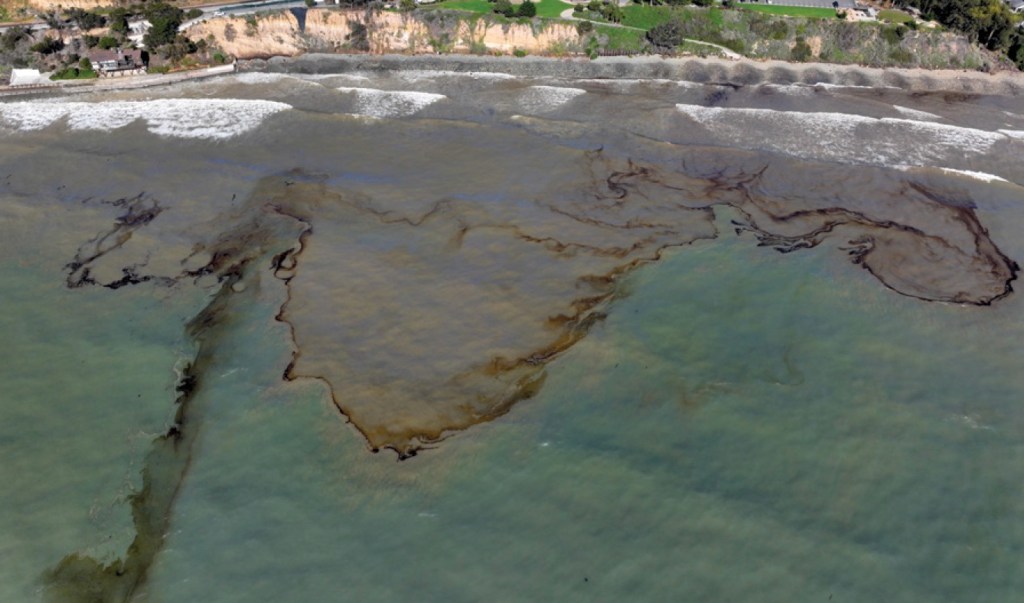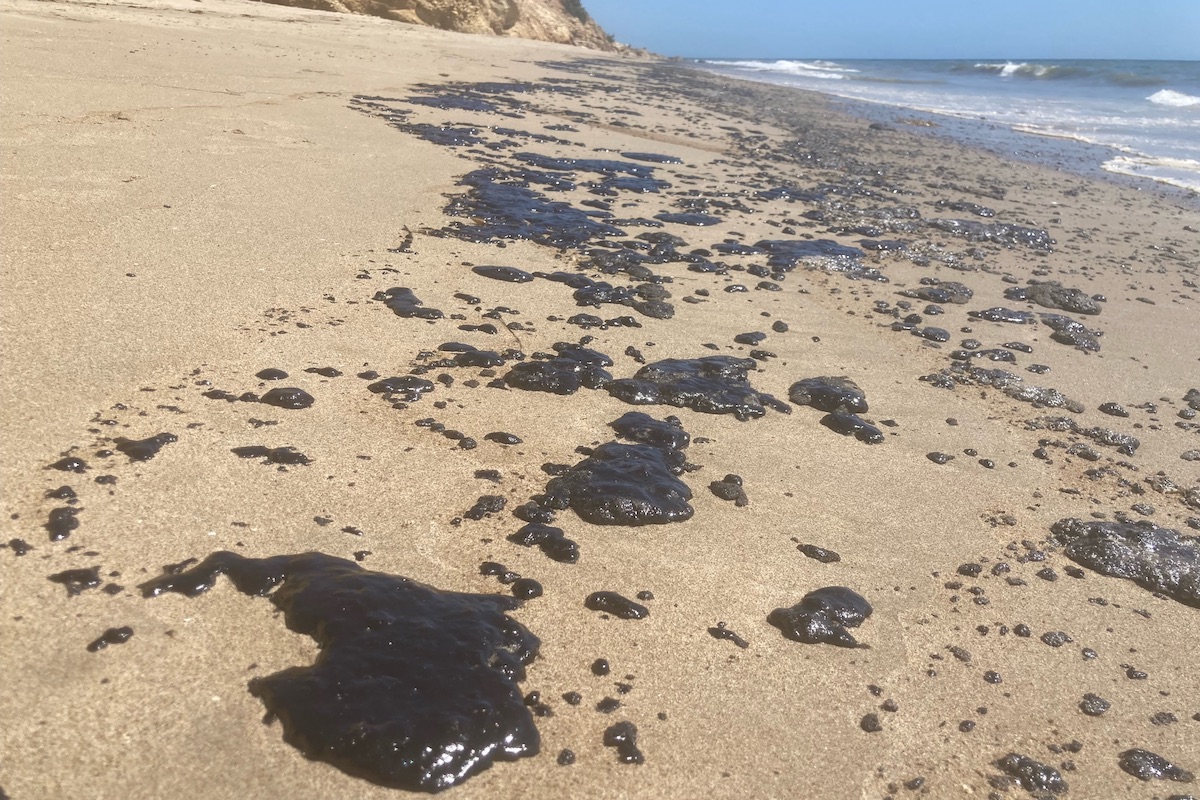A big, black raft was bobbing among the waves at Loon Point on Tuesday, headed for the shoreline midway between Summerland and Carpinteria. “I thought it was a kelp bed floating toward the beach,” said Jon Vaccaro, who watched as the giant mass washed up, breaking into thick gobs of smelly tar as the waves dumped it along the beach.
Once the petroleum mess had come ashore, Vaccaro said he considered going for a swim through a clear spot, but the ocean was left with a foamy brown color flecked with bits of goo that stuck to his legs. Instead, he took photos of what he estimated to be a football field’s length of gooey tar, sending them to the Indy and wondering if the “cork” mentioned in Callie Fausey’s story about re-abandoning oil wells off Summerland might be responsible.

Offshore oil has a fractured history in Santa Barbara County, dating from Summerland’s boom and bust years circa 1897-1939, through to 2015’s Refugio Oil Spill, which caused Venoco’s bankruptcy after a crucial pipeline split open. The oil giants left holding the bag are fighting to keep pulling petroleum out of the depths, with ownership of the ruptured pipeline above Refugio Beach to be litigated before the County Board of Supervisors this Tuesday. But persistent seeps of crude have floated up from cracks beneath the waves since before Chumash times.
At Butterfly Beach in early August, the waves left behind a soft, sticky crude on a stretch of sand that is reputed to have very little tar. No one with the parks or harbor knew where it could have come from, and everyone said to contact Heal the Ocean.
The nonprofit’s field researcher Harry Rabin has been tracking tar balls ever since he saw brown waves of oily foam at Miramar Beach in 2016 and used a drone to follow it two miles east to Summerland. There, at the site of the world’s first offshore oil wells, seven wells quietly oozing crude under the sands and waves have been re-abandoned, or closed with concrete and steel, since 2018. The last two — Treadwell #1 and #5 — were finished in mid-August, a few weeks before Vaccaro’s encounter. Rabin wasn’t surprised to learn of the big burp of tar but doesn’t believe it’s necessarily related to the well capping.

The State Lands Commission has been putting the $2 million a year provided by Senate Bill 44, authored by Santa Barbara’s former state senator, Hannah-Beth Jackson, to close the old wells that are now leaking. Subsequent seepage from other fractures wasn’t unexpected, and Heal the Ocean is working with Ira Leifer’s Bubbleology Research International to study the leaky wells and plot the reservoirs of oil that remain below.
Leifer stated that the Treadwell Wharf in Summerland — which went 1,200 feet out over the water and had about 19 wells on it in 1900 — tapped a fracture zone called the Ortega fault. He said the fault could shift and the “dinosaur goop” might migrate upward, or that the crude found a new path after the wells were capped. Pressures had increased as well after the heavy waves and record rainfall this winter recharged the aquifers extending under the ocean.
Rabin added that the tar he’d seen along the beach no longer released the rainbow sheen that marked a fresh glob of oil. With the rotation of the gyre in the Santa Barbara Channel, it’s possible the tar could have floated from Coal Oil Point near UC Santa Barbara, or that it’s the product of a natural seep somewhere out in the channel.
“Some fraction of the goop circles the gyre, and when it returns encrusted with barnacles, you know it’s been out there for some time,” Leifer said.

[Click to enlarge] Heal the Ocean mapped the historic well sites off Summerland. | Credit: Heal the Ocean
Heal the Ocean’s study with Leifer’s company will include working with the U.S. Geological Survey to “fingerprint” the Summerland well seeps and the tar washing ashore to get a better idea of where they’re coming from. This unique science would take apart the chemical composition of the various offshore oil sources and will require some serious analytical horsepower, said David Valentine, a geoscientist and underwater oil expert at UCSB who’d also been talking with Heal the Ocean.
“I’ve looked at some oils from Summerland before, and the field there has very different oils from seeps I’ve looked at in the area. So, differentiating the oil field should be simple — meaning you could tell if a tar ball is from Summerland versus Goleta or Point Conception,” Valentine said. If material from wells were to be compared, there could be subtle differences in their chemical composition, he surmised, but there was also a potential they could be indistinguishable.
“This will be a non-trivial task,” Valentine said. “That’s science code for really difficult with a moderate probability of failure.”
At the beaches, the tar gets on feet, into hair, and under bathing suits, and it coats surf and boogie boards. “What I liked about Loon Point is that it is usually much cleaner,” said Vaccaro. “I understand that we want to cap the old wells, but these cracks in the earth are unfortunate.” As for Loon Point, he hasn’t been back.
Correction: The State Lands Commission, not Heal the Ocean, is undertaking the capping of the Summerland offshore wellheads.





You must be logged in to post a comment.